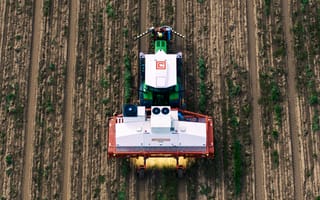Hiring tractor operators is a hit-or-miss undertaking.
That’s according to Jarod White, a lead embedded software engineer at Carbon Robotics. He explained that there are many challenges farmers face when hiring tractor operators, such as labor shortages, which make it difficult to find operators who can run night shifts or work in remote areas. Ideally, farmers would be able to run their tractors autonomously day and night during the season.
Carbon Robotics’ new Carbon AutoTractor is designed to confront these challenges, enabling reliable tractor autonomy with remote supervision by trained Carbon operators who can intervene if needed via a low-latency, high bandwidth connection.
“Carbon AutoTractor removes labor from the equation, allowing farmers to operate reliably, anytime and anywhere,” White said.
As is the case for most products the company builds, Carbon AutoTractor didn’t stay in the shop for too long. White shared that the first tractor was field-tested after just a month or two after the project started, enabling his team to confront — and overcome — roadblocks early on in the process.
In a workplace where “nearly everything” is cross-functional, he and his peers relied heavily on each other to bring the product to fruition, leaning on the same teamwork that brought the company’s other solution, the LaserWeeder™, to life.
“Everyone here is smart, motivated and used to solving hard problems as a team,” White said.
The Carbon AutoTracker marks a milestone for Carbon Robotics, addressing a “critical need for autonomy” in agriculture. Below, White shares more about what gave rise to the product, the impact it will have on farmers and how he and his peers banded together to create it.
About Carbon Robotics
Carbon Robotics is revolutionizing agriculture with AI and robotics to reduce costs and increase yields. Amid labor challenges, rising input costs, and increasing concerns about herbicide use, growers worldwide are seeking smarter, more efficient ways to farm. Carbon Robotics addresses these needs by delivering advanced AI robotic laser weeders and tractor autonomy that drives efficiencies to the global community.

What gave rise to the Carbon AutoTractor, and what impact will its launch have on Carbon Robotics’ customers?
Agriculture has a critical need for autonomy due to volatile labor markets, high labor costs and inconsistent work quality. Hiring tractor operators is hit-or-miss — some are attentive and efficient, while others can be careless or much less productive. Labor shortages also make it difficult to run night shifts or operate in remote areas.
Carbon AutoTractor removes labor from the equation, allowing farmers to operate reliably, anytime and anywhere. It’s an autonomy kit that adds vision systems, remote tractor controls and satellite connectivity to existing tractors, enabling low-latency, high-fidelity tractor control from anywhere in the world. Growers run tractors 24/7 with remote monitoring by trained Carbon Robotics operators who intervene as needed.
What role did you play in developing and launching the product, and what processes went into the development process?
As an embedded engineer, I sit between software and hardware, developing electronics and firmware. One of the initial challenges was understanding tractor control systems. Unlike most embedded work that begins with datasheets and specifications, this project started hands-on, working directly with tractors. At Carbon, things rarely stay in the shop for long. Just a month or two in, we had our first tractor remotely driving in the field. That’s where the real challenges and opportunities reveal themselves.
Field testing is core to our culture — reliability matters. I personally spent hundreds of hours in the cab writing code for tractor controls, such as hydraulics, speed and steering. Some of my favorite moments have been working late into the night alongside other engineers in the field, troubleshooting issues and seeing them resolved the next day. My role as lead embedded software engineer involved laying the foundation for Carbon AutoTractor’s control systems.
“Field testing is core to our culture — reliability matters.”

What obstacles did you encounter along the way, and how did you successfully overcome them?
This was an unusual project — we started by working directly with the tractor itself. Mechanically, electrically and in software, we explored every angle to understand how it worked and how to control it. We developed tools to interface with the controller area network bus inside the cab, ultimately gaining control over everything the in-cab operator can — hydraulic selector control valves, power take-off, lights and more. Many retrofit companies go the intensive hydraulic modification route. We initially thought we’d have to as well, but discovering that we could leverage the in-cab drive-by-wire systems was a breakthrough. It gave us full control with almost no physical modification to the tractor. Our system is minimally invasive and allows seamless handoff between autonomy and human control; pressing any button in the cab immediately overrides the autonomous system.
What strategies did your team employ to ensure that cross-functional collaboration went smoothly while building the Carbon AutoTractor?
Nearly everything at Carbon Robotics is cross-functional. Our team has years of experience working together on LaserWeeder, which brought together electrical, mechanical, robotics, systems, machine learning, front-end and back-end engineers. Everyone here is smart, motivated and used to solving hard problems as a team. We leaned on this existing culture to move fast on Carbon AutoTractor. While many companies treat “interdisciplinary” as just front-end and back-end collaboration, at Carbon, it’s the real deal — software engineers handle computer numerical control for parts of the machine, and hardware engineers design vision systems. The collaboration is hands-on from end to end.
“While many companies treat ‘interdisciplinary’ as just front-end and back-end collaboration, at Carbon, it’s the real deal — software engineers handle computer numerical control for parts of the machine, and hardware engineers design vision systems.”

When you think of other companies in your industry, how does Carbon Robotics compare when it comes to building and launching new products?
Carbon is unique in the robotics and hardware startup world. Most companies struggle to get beyond pilot programs. In three years, Carbon has shipped well over 150 machines to 12 countries, generating well over nine figures in total sales. What sets us apart is our culture. We hire exceptional engineers and give them the room and tools to do their best work. When people walk into our office and see the no-nonsense, engineering-first approach, they either love it or know it’s not for them. For me, it clicked immediately.
Engineers here are empowered; LaserWeeder is a complex, high-impact product that could only be built in an environment like this. Every day brings new challenges, from sub-millimeter precision weed targeting to full-field coverage planning in complex environments. It’s a deeply technical and high-leverage place to build breakthrough innovations.







